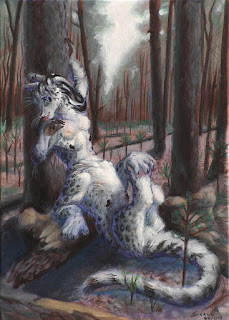
A portrait of chakasa Bluefire done as a present for my good friend leonardo. Bluefire works as an Environmental Restorer, a rather difficult job which is basically fixing/cleaning up the mess left by the late industrial age, back when earthlings deluded themselves that the planet's resources could be exploited without limits.
Most of hir job revolves around slowly restroing soil fertility and biodiversity into barren areas, so that in a few centuries they can produce something again. Here however shi is just taking a pause into a recently burned down wood, where new saplings are beginning to grow back.
Acrylics on board. Unluckily no WIPs for this as I was very unsure while painting it and thought I'd have to restart any time, so I didn't make photos of the various stages... I really need to get past this stupid worrying. Also because now I'm able to correct most mistakes along the way.
For the palette I used many colors but the main components for the background are violet and phtalo green, the rest is various shades of gray done with combinations of blacks (Mars and ivory, the latter has the lowest value), titanium white, ultramarine, Van Dyck brown and yellow ochre.


























